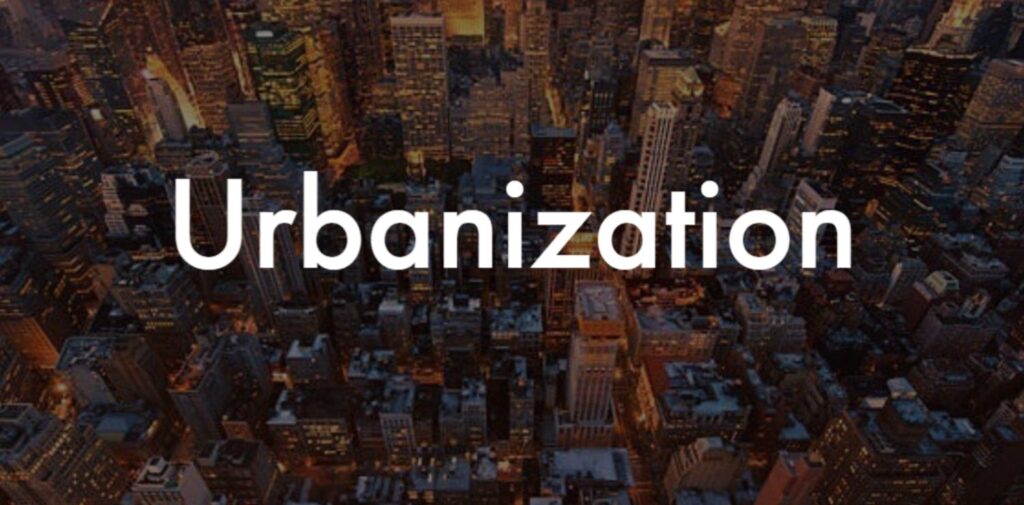Urbanization is a major trend in India, with more and more people moving from rural areas to cities. This shift has created both challenges and opportunities that shape the future of the country. In this article, we will explore what urbanization means for India, the problems it brings, and the possibilities it offers.
What is Urbanization?
Urbanization refers to the increasing number of people living in urban areas, such as cities and towns. In India, this process has been rapid. Since independence in 1947, the urban population has grown from about 17% to over 35%. By 2031, it is estimated that nearly half of India’s population will live in cities. This growth can be attributed to various factors, including better job opportunities, education, and healthcare facilities found in urban areas.

The Bright Side: Opportunities of Urbanization
- Economic Growth: One of the most significant benefits of urbanization is economic growth. Cities are engines of economic activity, where industries flourish, businesses thrive, and new job opportunities arise. Urban areas contribute a large share of India’s GDP. This concentration of economic activity can lead to increased productivity and innovation.
- Improved Infrastructure: Urbanization often brings improvements in infrastructure. Governments invest in roads, public transport, and utilities to accommodate growing populations. Better infrastructure can enhance the quality of life for residents, making cities more livable and accessible. Improved public transport systems, for instance, can reduce travel time and pollution.
- Access to Services: Cities provide better access to essential services like healthcare, education, and sanitation. Urban areas typically have more hospitals, schools, and public services than rural areas. This access can lead to better health outcomes, higher literacy rates, and improved living standards for residents.
- Cultural Exchange and Diversity: Urban areas are melting pots of culture, where people from different backgrounds come together. This diversity can foster creativity and innovation. Cities are often hubs for art, music, and cuisine, allowing people to experience a rich tapestry of cultures and traditions.

The Dark Side: Challenges of Urbanization
- Overcrowding: As more people move to cities, overcrowding becomes a significant issue. Many urban areas face challenges related to limited space and resources. This can lead to traffic congestion, strained public services, and a decline in living conditions. Overcrowding also puts immense pressure on housing, leading to a rise in informal settlements or slums.
- Pollution: Urbanization often contributes to environmental pollution. Increased vehicles, industrial activities, and construction contribute to air, water, and noise pollution. Poor air quality can lead to serious health issues, including respiratory problems. Cities like Delhi and Mumbai frequently struggle with pollution, affecting the health of millions.
- Inadequate Housing: With rapid urban growth, affordable housing becomes a major challenge. Many migrants move to cities seeking better opportunities but often find themselves in inadequate living conditions. Slums and informal settlements emerge where people live without basic amenities such as clean water, sanitation, and electricity. This lack of proper housing affects the overall quality of life and social stability.
- Unemployment and Informal Economy: While cities offer job opportunities, they also face high rates of unemployment. The influx of rural migrants can saturate the job market, making it challenging for everyone to find work. Many people end up in the informal economy, where they work without job security or benefits. This can lead to exploitation and poor working conditions.

Balancing Challenges and Opportunities
To make the most of urbanization, India must address the challenges while harnessing the opportunities. This requires a multi-faceted approach involving government policy, community engagement, and sustainable practices.
- Smart Urban Planning: Effective urban planning is crucial for managing growth. This means designing cities that are well-organized and equipped to handle increasing populations. Smart planning includes developing efficient public transport systems, green spaces, and affordable housing. It’s essential to involve local communities in the planning process to ensure that their needs are met.
- Sustainable Development: Sustainable development should be at the core of urbanization efforts. This involves using resources wisely and minimizing environmental impact. Cities can adopt green technologies, promote renewable energy, and encourage sustainable practices among residents. Initiatives like recycling, waste management, and the promotion of public transport can contribute to healthier urban environments.
- Enhancing Public Services: Governments must invest in public services to support growing urban populations. This includes improving healthcare facilities, expanding educational institutions, and ensuring access to clean water and sanitation. By enhancing these services, cities can improve the quality of life for their residents and reduce inequalities.
- Creating Job Opportunities: To combat unemployment, cities need to create more job opportunities. This can be achieved through encouraging entrepreneurship, supporting small businesses, and attracting investments. Skill development programs can also help equip the workforce with the necessary skills to meet the demands of a changing job market.
Conclusion: Urbanization in India
Urbanization presents both challenges and opportunities for India. While cities are vital for economic growth and development, they also face significant issues that need to be addressed. By focusing on smart urban planning, sustainable practices, and enhancing public services, India can turn the challenges of urbanization into opportunities for a better future.
As India continues to urbanize, it is essential to create inclusive and resilient cities that cater to the needs of all residents. With the right approach, urbanization can lead to a brighter and more prosperous future for everyone.




